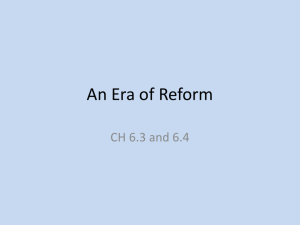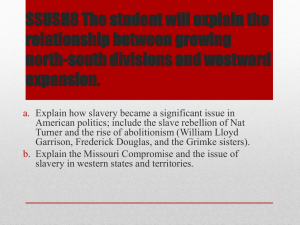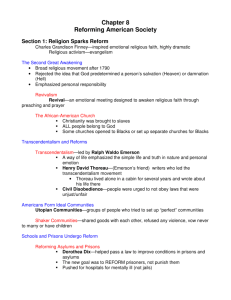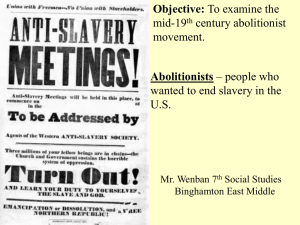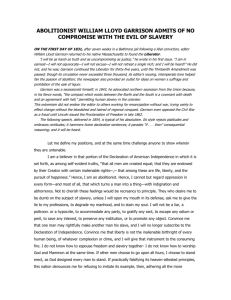Chapter 8:1- Religious Sparks Reform
advertisement
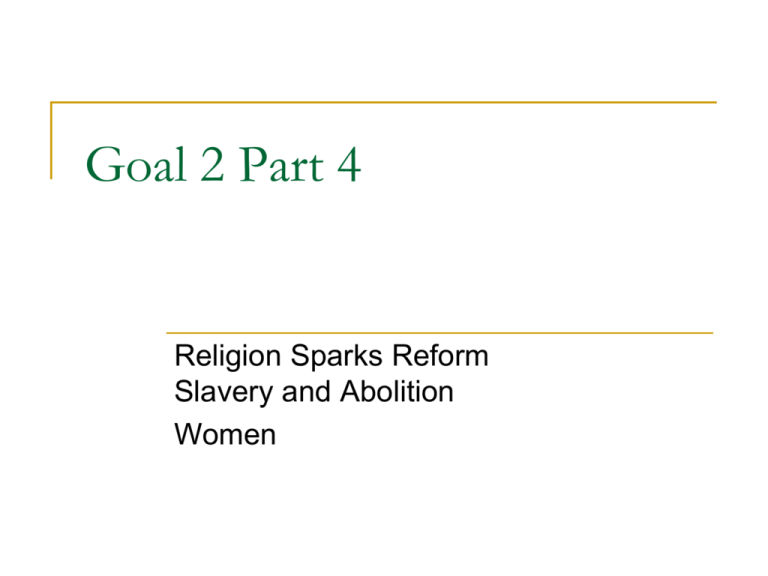
Goal 2 Part 4 Religion Sparks Reform Slavery and Abolition Women “Second Great Awakening” Ideas of 2nd Great Awakening: (1) reject the 18th-century Calvinistic belief of “predetermination” (2) Focus on “individual salvation” Promoted: (a) INDIVIDUALISM (b) RESPONSIBILITY (c) SELF-RELIANCE Charles G. Finney “the father of modern revivalism” – the Rochester Revivals (New York) Spoke on salvation through individuality Promoted the idea of many different denominations Hudson River School Art school that promoted “American landscapes” and demoted the paintings of “European landscapes” Nationalism increased!!!!!!!!! (natural America) **Ralph Waldo Emerson** **Henry David Thoreau** “TRANSCENDENTALISM” – philosophical and literary movement that emphasized and celebrated the “simple life” and personal imagination emotion…..optimism and self-reliance Built a cabin in Massachusetts, locked himself in and lived alone for 2 years - Famous literature: Walden “Civil Disobedience” - urged people to “PEACEFULLY” disobey laws that are unjust ROMANTICISM (1820-1850) A style of literature, art and thought in the mid-1800s that stressed the human development of emotional forms of expression, nature and emotion. – Authors used American setting, American characters, and American themes Helped promote the Hudson River School Why important: American authors writing about America themes for American people Examples of “Romantic” Authors Ralph Waldo Emerson (Transcendentalism) Henry David Thoreau (Civil Disobedience) James Fennimore Cooper (Last of the Mohicans) Edgar Allen Poe – American poet (The Raven) Washington Irving – (Legend of Sleepy Hollow) Nathaniel Hawthorne – (The Scarlet Letter) Noah Webster – (Webster’s Dictionary) All of these authors raised nationalism because they were all AMERICANS with AMERICAN themes – before most authors were from EUROPE with EUROPEAN themes Utopian communities (1820-1850) - Experimental groups that tried to create the “PERFECT” place or “utopia”. “prepare a society of liberal, intelligent and cultivated persons, whose relations with each other would permit a more wholesome and simple life that can be led amongst the pressures of our competitive institutions” - George Ripley (transcendentalist) * EXAMPLES: (Brook Farm and New Harmony) Result: didn’t work due to (1) Lack of mainstream resources (2) Laziness of patrons PRISON REFORM “DOROTHEA DIX” visited Massachusetts and saw the horrors of prisons and decides to reform / improve the conditions Worked for the “mentally ill” inmates Urged for the government to establish separate facilities Also introduced the idea of “Rehabilitation” SCHOOL REFORM “HORACE MANN” Main Goal: get students ready for society / good citizens Curriculum reforms and teacher training Example: With Mann’s actions, every state have a policy for elementary schools. Analyze the impact of each movement or figure on the Reform movement in the mid 1800s (1) 2nd Great Awakening (2) Charles G. Finney (3) Hudson River School (4) Ralph Waldo Emerson (5) Henry David Thoreau (6) Dorothea Dix (7) Horace Mann Slavery and Abolition Abolition = a call to outlaw slavery in America, ****** William Lloyd Garrison ****** (ABOLITIONIST) Goal: an immediate “emancipation / abolition” of slavery with no payment to the slaver owner! Started his own newspaper called ****The Liberator*** – spoke of ways to end slavery- I WILL BE HEARD! (most famous abolitionist paper) Also founded the “American Anti-Slavery Society” Abolitionists David Walker *Published the “Appeal” to the Colored Citizens of the World literature passed around the South Spoke of “standing up and fighting for your freedom as a slave” (Don’t wait on emancipation…. FIGHT for it) (D.W. = Don’t walk…RUN!) Frederick Douglass An escaped slave that supported Garrison and The Liberator Lecturer or Orator at the American Anti-Slavery Society conventions. Wrote his own newspaper: ******The North Star****** Nat Turner’s Rebellion Considered the “most successful” slave rebellion Followed “DAVID WALKER’S ideas” Nat Turner –a preacher born into slavery in 1800 in Virginia Saw an eclipse in the sky (divine message) to free slaves Attacked 4 plantations with 80 followers (killed 60 white people) Nat Turner – hid, found, tried, hanged Main result of the Nat Turner Rebellion Whites killed roughly 200 African Americans *****This bloody rebellion made the white slaveholders become more STRICT and more controlling! *(SLAVE CODES) – state legislation over slaves! Slave owners = VERY NERVOUS! Slave Owners DEFEND Slavery (1) Bible – citing passages that claimed servants should obey their masters / Slaves are being “Christianized” (2) Myth of a “happy” slave / happy addition to the plantation family (3) Abolitionists would SWAMP Congress with antislavery petitions and Southern representatives countered by securing a “GAG RULE” – a rule limiting the reading of an issue in Congress – repealed years later (4) Southern economy (5) Paternalism Women in the th 19 century 19th century woman – limited option and opportunities (remember 1824-1828 voting population left them out) “Cult of Domesticity” – childcare and housework Female Abolitionist Sarah and Angelina Grimke An Appeal to Christian Women of the South Distributed literature, raised money Supported by William Lloyd Garrison MAIN REASON WHY THEY GOT INVOLVED Anti-slavery issues COULD lead to women’s rights issues! TEMPERANCE MOVEMENT The effort that criticizes excessive drinking of ALCOHOL Problem: alcohol is everywhere! (1) American Temperance Society (2) Women’s Christian Temperance Union (WCTU) July 19-20 (1848) Lucretia Mott and Elizabeth Cady Stanton – MAIN GOAL:“WOMEN’S RIGHTS” (SUFFRAGE) VERY FIRST WOMEN’S RIGHTS CONVENTION *********“Declaration of Sentiments”********** (famous document) Based loosely on the Declaration of Independence but sheds light on “WOMEN’S RIGHTS” **** SUSAN B. ANTHONY = leading women’s suffrage leader *Mott, Stanton & Anthony help found the National Women’s Suffrage Association (NWSA) T.Q. What did the Seneca Falls Convention accomplish for the women’s rights movement? a. a series of education and health reforms b. equal property rights with men c. a series of resolutions stating women’s grievances d. the right to vote Analyze the impact of each American figure on the Abolitionist movement William Lloyd Garrison David Walker Frederick Douglas Nat Turner Harriet Tubman Slave Defender WCTU Elizabeth Stanton, Lucretia Mott and Susan B. Anthony Sojourner Truth Impact of Social Reform Create a visual summary of the IMPACT of social reform in America during the mid 19th century.
